There is a line out there.
One side of the line is Sanity. The other side of the line is Hobby.
Guess which side of the line is expensive ($$$).
One side of the line is Sanity. The other side of the line is Hobby.
Guess which side of the line is expensive ($$$).
Found these... Might be marde, might be good, but for like 50$/pair the price is good enough to give em a try...
2X(5K 5W Single-Ended 6P1 6P14 6P6 Tube Amp Output Audio Transformers Impor4Y6) | eBay
i got a pair of these for U$35, about two months ago, the prices have been climbing steadily since...
i made a pair of these by hand, with exactly the same spec for about U$25 a pair, diy....
these are 3/4 in center leg with 1 inch stack Z11/m6 irons...
There is a line out there.
One side of the line is Sanity. The other side of the line is Hobby.
Guess which side of the line is expensive ($$$).
sanity, because you can not stop until the what if is answered...
Just in case that someone may have doubts about what I made I have attached pictures.
A SE 6L6GC build with James 15W UL OPT and mains transformers plus James choke (green chassis - build in 2010).
In 2013 I build a small 6BQ5 SE with Transcendar 10W UL OPT and Hammond PT. (arctic white)
3 years ago I build an Audio Note kit 4 clone with Hashimoto HWC-30-8 OPT and Hammond TP (blank aluminum chassis).
The James transformers kept on giving off a synthetic smell that eventually caused me to sell it. Although the choke was oversized it ran very hot - could not touch it for more than 1 second. The James transformers were presented as being build by someone who made transformers for Tango.
The small SE 6BQ5 - I sold it because of a mistaken belief that I needed a larger amplifier.
The Audio Note - there was a measurable difference in the performance of the two OPT, both in frequency, resistance and output. Most noticeable one would expect with CT that the resistance in both legs was the same however this is not the case, this meant it was not bifilar would. Was disappointed in the quality.
The 6BQ5 has gone to an audiophile who has an assortment of amplifiers and it is his most favortie above a Leak20.
To my ears (and I do not regard myself as an audiophile) I liked the little 6BQ5 the best and am going back to something similar:
I will be using a 5670W (6N3P-E) input tube and using 7W UL Transcendars with a 22.5% UL tap (!) OPT's and a Transcendar Mains PT.
A SE 6L6GC build with James 15W UL OPT and mains transformers plus James choke (green chassis - build in 2010).
In 2013 I build a small 6BQ5 SE with Transcendar 10W UL OPT and Hammond PT. (arctic white)
3 years ago I build an Audio Note kit 4 clone with Hashimoto HWC-30-8 OPT and Hammond TP (blank aluminum chassis).
The James transformers kept on giving off a synthetic smell that eventually caused me to sell it. Although the choke was oversized it ran very hot - could not touch it for more than 1 second. The James transformers were presented as being build by someone who made transformers for Tango.
The small SE 6BQ5 - I sold it because of a mistaken belief that I needed a larger amplifier.
The Audio Note - there was a measurable difference in the performance of the two OPT, both in frequency, resistance and output. Most noticeable one would expect with CT that the resistance in both legs was the same however this is not the case, this meant it was not bifilar would. Was disappointed in the quality.
The 6BQ5 has gone to an audiophile who has an assortment of amplifiers and it is his most favortie above a Leak20.
To my ears (and I do not regard myself as an audiophile) I liked the little 6BQ5 the best and am going back to something similar:
I will be using a 5670W (6N3P-E) input tube and using 7W UL Transcendars with a 22.5% UL tap (!) OPT's and a Transcendar Mains PT.
Attachments
-
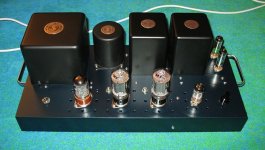 IMG_2209.JPG119.7 KB · Views: 394
IMG_2209.JPG119.7 KB · Views: 394 -
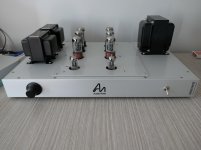 P1000545.jpg516.8 KB · Views: 164
P1000545.jpg516.8 KB · Views: 164 -
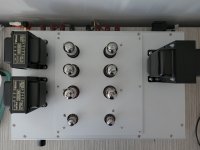 P1000544 small.jpg156.7 KB · Views: 172
P1000544 small.jpg156.7 KB · Views: 172 -
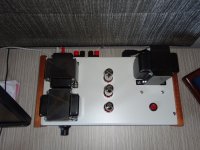 DSC01201.JPG465.3 KB · Views: 152
DSC01201.JPG465.3 KB · Views: 152 -
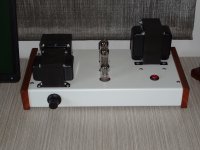 DSC01199.JPG461 KB · Views: 151
DSC01199.JPG461 KB · Views: 151 -
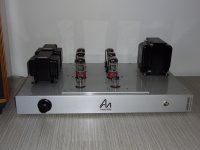 DSC00928 small.jpg182.1 KB · Views: 375
DSC00928 small.jpg182.1 KB · Views: 375 -
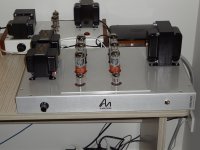 DSC00866 small.jpg904.9 KB · Views: 361
DSC00866 small.jpg904.9 KB · Views: 361 -
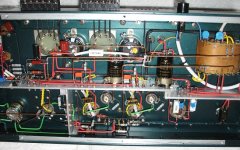 IMG_2212.JPG118.6 KB · Views: 383
IMG_2212.JPG118.6 KB · Views: 383 -
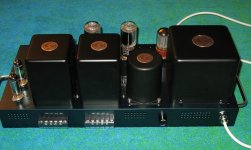 IMG_2211.JPG116.2 KB · Views: 395
IMG_2211.JPG116.2 KB · Views: 395 -
 P1000484 small.jpg138.8 KB · Views: 161
P1000484 small.jpg138.8 KB · Views: 161
Last edited:
The new SE 6BQ5 will have a soft start B+. It took me a little while to come up with something simple: The HT winding will have 4 NTC resistors of 200 Ohm and a maximum current of 500mA in series. (before the bridge rectifier) There will be a 100K resistor to ground from B+ to limit the B+ when there is not yet a current draw through the tubes. When the tubes heat up the NTC resistors will heat up and lower the resistance and bring up B+. After 60 seconds an Amperite 6N060 delay relay will come on that shorts the NTC resistors. This allows the relay to work within its operating characteristics and is kind on the transformer (with not having a large in-rush current at startup) and limiting B+ at cold start so it is not damaging the driver.
I'll mount the delay relay like it is a rectifier tube.
I'll mount the delay relay like it is a rectifier tube.
Attachments
Last edited:
i used the NTC at the power traffo primary, in series with the fuse and power traffo primary winding.......10 ohm cold resistance, below an ohm when running current, the power traffo has primary dc resistance of between 4 to 20 ohms, this is how i did my tube amps...
tbh, i see no point why anyone would short it out, just stick them in and forget...
tbh, i see no point why anyone would short it out, just stick them in and forget...
Last edited:
i used the NTC at the power traffo primary, in series with the fuse and power traffo primary winding.......10 ohm cold resistance, below an ohm when running current, the power traffo has primary dc resistance of between 4 to 20 ohms, this is how i did my tube amps...
tbh, i see no point why anyone would short it out, just stick them in and forget...
I have about 800 Ohm in there, when heated up still around 40 Ohm. The 5670W does not like over 300VDC when cold and if using smaller NTC's then the voltage goes far above the 300 VDC.
You'll want the NTC cold for when the power goes off and comes back on. (they take a while to cool down)
Last edited:
i get my NTC's from atx psu's and ranged from 4 ohms to 14 ohms....i have yet to see an 800 ohm ntc..
Just in case that someone may have doubts about what I made I have attached pictures.
A SE 6L6GC build with James 15W UL OPT and mains transformers plus James choke (green chassis - build in 2010).
In 2013 I build a small 6BQ5 SE with Transcendar 10W UL OPT and Hammond PT. (arctic white)
3 years ago I build an Audio Note kit 4 clone with Hashimoto HWC-30-8 OPT and Hammond TP (blank aluminum chassis).
The James transformers kept on giving off a synthetic smell that eventually caused me to sell it. Although the choke was oversized it ran very hot - could not touch it for more than 1 second. The James transformers were presented as being build by someone who made transformers for Tango.
The small SE 6BQ5 - I sold it because of a mistaken belief that I needed a larger amplifier.
The Audio Note - there was a measurable difference in the performance of the two OPT, both in frequency, resistance and output. Most noticeable one would expect with CT that the resistance in both legs was the same however this is not the case, this meant it was not bifilar would. Was disappointed in the quality.
The 6BQ5 has gone to an audiophile who has an assortment of amplifiers and it is his most favortie above a Leak20.
To my ears (and I do not regard myself as an audiophile) I liked the little 6BQ5 the best and am going back to something similar:
I will be using a 5670W (6N3P-E) input tube and using 7W UL Transcendars with a 22.5% UL tap (!) OPT's and a Transcendar Mains PT.
Thanks for providing the details and your thoughts on them. Nice amps!
One thing that I have noticed is that there are significant differences in primary DCR between all of the OPTs that I am considering. I'd like to understand what the pros and cons are of low vs. high DCR on the primary of an OPT. For example one OPT I am looking at has a DCR of ~100ohms and another is closer to ~400ohms (despite them both having a primary impedance of 5kohms).
Would it be correct to assume lower primary DCR results in higher efficiency and less load/stress on the power tubes?
OPT primary inductance also varies wildly from one to the next (6H vs. 40H, for example). If someone could also shed some light on this I would appreciate it!
Would it be correct to assume lower primary DCR results in higher efficiency and less load/stress on the power tubes?
OPT primary inductance also varies wildly from one to the next (6H vs. 40H, for example). If someone could also shed some light on this I would appreciate it!
Last edited:
One thing that I have noticed is that there are significant differences in primary DCR between all of the OPTs that I am considering. I'd like to understand what the pros and cons are of low vs. high DCR on the primary of an OPT. For example one OPT I am looking at has a DCR of ~100ohms and another is closer to ~400ohms (despite them both having a primary impedance of 5kohms).
Would it be correct to assume lower primary DCR results in higher efficiency and less load/stress on the power tubes?
OPT primary inductance also varies wildly from one to the next (6H vs. 40H, for example). If someone could also shed some light on this I would appreciate it!
If I remember correctly (and it is all mentioned in the Radiotron Designers Handbook by J Langford-Smith, can download it from Pete Millett's website: tubebooks.org):
At a 5000 ohm primary inductancy wou will need about 30 ~ 40H to have little distortion (and full power transfer) at 50Hz. (at 2500 it can be half of that inductance).
The DC resistance causes a DC voltage resulting in that the tube sees a lower voltage between plate and cathode. Basically the less DC resistance and the higher inductancy suggests (!) a better transformer.
But... the more windings (to get higher inductancy) the more capacitance happens between the windings which causes other problems, most noticeably the HF response.
In the end it is a fine balancing act.
Last edited:
I would personally use Transcendar series feed output transformers before I used James/Hashimoto.
In my experience with the high end Japanese series feed iron, they give up too much on the low end to have very flat frequency response way out past where I can hear. I'd rather have my iron -1dB at 20kHz/15Hz rather than -1dB at 40kHz/40Hz.
In 2018 I helped a friend assemble a gorgeous 7788/2A3 amp with big James series feed output transformers, and the difference between this amp and my parallel feed 2A3 amps in the bass department was immediately apparent.
In my experience with the high end Japanese series feed iron, they give up too much on the low end to have very flat frequency response way out past where I can hear. I'd rather have my iron -1dB at 20kHz/15Hz rather than -1dB at 40kHz/40Hz.
In 2018 I helped a friend assemble a gorgeous 7788/2A3 amp with big James series feed output transformers, and the difference between this amp and my parallel feed 2A3 amps in the bass department was immediately apparent.
If I remember correctly (and it is all mentioned in the Radiotron Designers Handbook by J Langford-Smith, can download it from Pete Millett's website: tubebooks.org):
At a 5000 ohm primary inductancy wou will need about 30 ~ 40H to have little distortion (and full power transfer) at 50Hz. (at 2500 it can be half of that inductance).
The DC resistance causes a DC voltage resulting in that the tube sees a lower voltage between plate and cathode. Basically the less DC resistance and the higher inductancy suggests (!) a better transformer.
But... the more windings (to get higher inductancy) the more capacitance happens between the windings which causes other problems, most noticeably the HF response.
In the end it is a fine balancing act.
Very interesting. Thank you, and thanks also for the tip about Mr. Millett's site!
I am puzzled, however - The Hammond 1628SE/SEA is well known to produce ridiculously low, powerful bass (George Anderson is not the only one to claim this) and yet its primary inductance is just 16.2 H. George has said that the Hammond is audibly better at bass than the EdCor CXSE-25-5K, which is 1/2 pound heavier than the Hammond and has a primary inductance of 50 H.
It seems that Henries aren't the only way to get solid bass.
At a 5000 ohm primary inductancy wou will need about 30 ~ 40H to have little distortion (and full power transfer) at 50Hz.
Z=2*pi*f*L
L=Z/(2*pi*f)
L=5000/(2*3.14159*20) at 20Hz
L=39.79H at 20Hz
L=15.91H at 50Hz
I would personally use Transcendar series feed output transformers before I used James/Hashimoto.
In my experience with the high end Japanese series feed iron, they give up too much on the low end to have very flat frequency response way out past where I can hear. I'd rather have my iron -1dB at 20kHz/15Hz rather than -1dB at 40kHz/40Hz.
In 2018 I helped a friend assemble a gorgeous 7788/2A3 amp with big James series feed output transformers, and the difference between this amp and my parallel feed 2A3 amps in the bass department was immediately apparent.
The Transcendars are getting more and more tempting. Thanks for your thoughts on this.
I was able to dig up more specifications on the cheap Chinese ones that are currently on their way to me.
- Power: 8W (20Hz)
- Frequency response: 20Hz-40KHz, -3dB
- Primary: 5000Ω
- Secondary: 0-8Ω, or 0-4-8Ω
- Core size: EI66 stack thickness 35mm
- Dimensions: length 68MM + two fixed screws 30MM;width: 65MM;high 60MM
- Material: Japan imported z11 sheet
- Primary copper resistance: about 408Ω (B-P),
- Inductance: 38H
- Primary maximum allowable DC: 100mA
- Suitable for 6P14 (el34, el84, 6p3p)
- Weight : 1kg
Spec-wise they are nearly on-par with the Transcendar 7W 5kohm units. Perhaps it makes sense to take them more seriously than I have been.
- Power: 8W (20Hz)
- Frequency response: 20Hz-40KHz, -3dB
- Primary: 5000Ω
- Secondary: 0-8Ω, or 0-4-8Ω
- Core size: EI66 stack thickness 35mm
- Dimensions: length 68MM + two fixed screws 30MM;width: 65MM;high 60MM
- Material: Japan imported z11 sheet
- Primary copper resistance: about 408Ω (B-P),
- Inductance: 38H
- Primary maximum allowable DC: 100mA
- Suitable for 6P14 (el34, el84, 6p3p)
- Weight : 1kg
Spec-wise they are nearly on-par with the Transcendar 7W 5kohm units. Perhaps it makes sense to take them more seriously than I have been.
One thing that I have noticed is that there are significant differences in primary DCR between all of the OPTs that I am considering. I'd like to understand what the pros and cons are of low vs. high DCR on the primary of an OPT. For example one OPT I am looking at has a DCR of ~100ohms and another is closer to ~400ohms (despite them both having a primary impedance of 5kohms).
Would it be correct to assume lower primary DCR results in higher efficiency and less load/stress on the power tubes?
OPT primary inductance also varies wildly from one to the next (6H vs. 40H, for example). If someone could also shed some light on this I would appreciate it!
DCR is due to the wire size used, and what application....
but if you mean same traffo, such a dcr spread is not acceptable, you can have a variation between units by a few ohms and that will be fine...but not that much..
DCR is due to the wire size used, and what application....
Makes sense. Quality of wire would matter as well. I am more wondering how DCR affects overall amplifier performance. George has mentioned many times that certain OPTs are noticeably less efficient (by a watt or two) than others (all else being equal). I suspect DCR is a part of this but I am not knowledgeable enough to "know". 🙂
but if you mean same traffo, such a dcr spread is not acceptable, you can have a variation between units by a few ohms and that will be fine...but not that much..
No, I was speaking about comparing one manufacturer/model to another. Your point here makes a lot of sense though.
- Primary: 5000Ω
- Inductance: 38H
- Frequency response: 20Hz-40KHz, -3dB
Those three specs don't seem likely to cohabitate inside the same transformer. The DCR specification makes me think that they may hit that inductance number, but then saying the TX is -3dB at 20Hz wouldn't make sense. Having that much copper and primary indcutance should also roll off the treble a little harder than it is IMO.
- Power: 8W (20Hz)
- Weight : 1kg
1kg is about half of what I would expect for such a transformer.
- Inductance: 38H
- Frequency response: 20Hz-40KHz, -3dB
Those three specs don't seem likely to cohabitate inside the same transformer. The DCR specification makes me think that they may hit that inductance number, but then saying the TX is -3dB at 20Hz wouldn't make sense. Having that much copper and primary indcutance should also roll off the treble a little harder than it is IMO.
- Power: 8W (20Hz)
- Weight : 1kg
1kg is about half of what I would expect for such a transformer.
- Power: 8W (20Hz)
- Weight : 1kg
1kg is about half of what I would expect for such a transformer.
Really? That's what Transcendar is building.
The 7 watt 5k version is 2.4 lbs. (1.1 kg) and the rest of the specs look like:
-Frequency Response: 20 Hz to 70 kHz +/- 1 dB @ 1 Watt
-Maximum DC Bias Current: 75 mA
-Primary DC Resistance: 325 ohms
-Primary Inductance: 30 H @ 120 Hz
To get a 5 pound Transcendar, you have to buy the 15W.
Last edited:
- Home
- Amplifiers
- Tubes / Valves
- SE Output xfmrs....who are the current suppliers for not many $$$